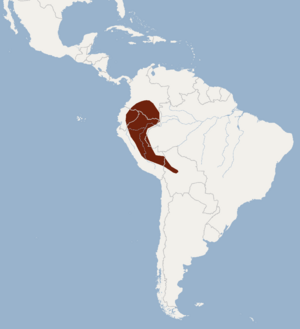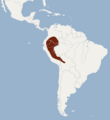Greater yellow-shouldered bat facts for kids
The greater yellow-shouldered bat (Sturnira magna) is a fascinating type of bat. It belongs to a group of bats called Phyllostomidae, also known as leaf-nosed bats. These bats are special because they have a unique leaf-shaped nose. You can find the greater yellow-shouldered bat living in several South American countries. These include Bolivia, Colombia, Ecuador, and Peru.
Quick facts for kids Greater yellow-shouldered bat |
|
|---|---|
| Conservation status | |
| Scientific classification | |
| Genus: |
Sturnira
|
| Species: |
magna
|
 |
|
Contents
What is the Greater Yellow-Shouldered Bat?
The greater yellow-shouldered bat gets its name from its appearance. It has patches of yellowish fur on its shoulders. These patches stand out against its darker body fur. This bat is a medium-sized mammal. It is known for its important role in its ecosystem.
Where Do These Bats Live?
This bat species lives in the tropical forests of South America. They prefer areas with lots of trees and plants. Their habitat includes dense forests and sometimes even fruit farms. They need these environments to find food and shelter.
Countries Where They Are Found
The greater yellow-shouldered bat lives in several countries. These are:
They are found in the warmer, wetter parts of these countries.
What Do Greater Yellow-Shouldered Bats Eat?
These bats are primarily frugivores. This means they love to eat fruit! They play a big part in spreading seeds. When they eat fruit, they later drop the seeds in new places. This helps new plants grow in the forest.
Favorite Fruits
The greater yellow-shouldered bat enjoys a variety of fruits. They often look for ripe fruits that are easy to find. Their diet helps keep the forest healthy. By spreading seeds, they help the forest regenerate.
How Do Bats Help the Environment?
Bats are very important for our planet. They help in many ways. Some bats eat insects, which helps control pest populations. Other bats, like the greater yellow-shouldered bat, are vital for plant life.
Seed Dispersal
When these bats eat fruit, they digest the pulp. The seeds pass through their bodies unharmed. They then drop these seeds in their droppings. This process is called seed dispersal. It helps forests grow and stay diverse.
Pollination
Some bats also help pollinate flowers. This means they carry pollen from one flower to another. This is similar to how bees help plants. Pollination is crucial for plants to make seeds and fruits.
Life Cycle and Reproduction
Bats have an interesting life cycle. Female bats usually give birth to one baby at a time. The baby bat is called a pup. Pups are born without fur and are very small.
Raising Young Bats
Mother bats care for their pups very well. They feed their pups milk until they are old enough to fly and find their own food. Pups grow quickly and soon learn to hunt for fruit.
Conservation Status
The greater yellow-shouldered bat is currently listed as "Least Concern" by the IUCN. This means their population is stable. However, like many animals, they face threats.
Threats to Bats
The biggest threat to these bats is habitat loss. Forests are being cut down for farming or building. This reduces the places where bats can live and find food. It's important to protect their homes.
Protecting Bat Habitats
Conservation efforts aim to protect bat habitats. This includes preserving forests and educating people about the importance of bats. By protecting bats, we help keep our ecosystems healthy.
Images for kids
See also
 In Spanish: Sturnira magna para niños
In Spanish: Sturnira magna para niños



